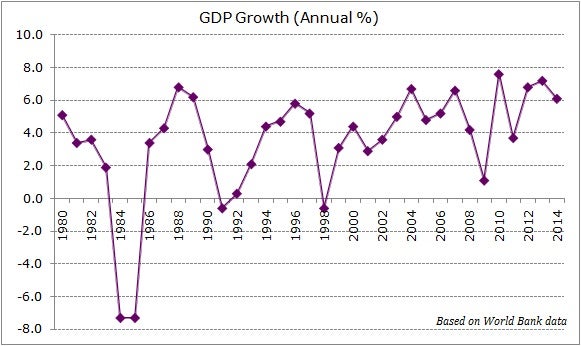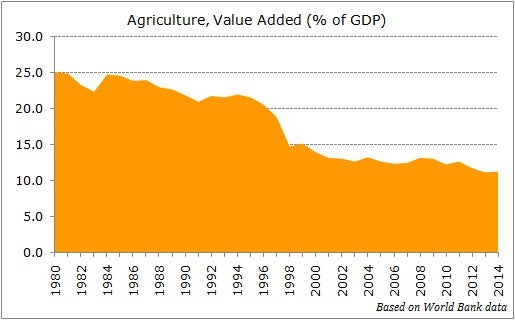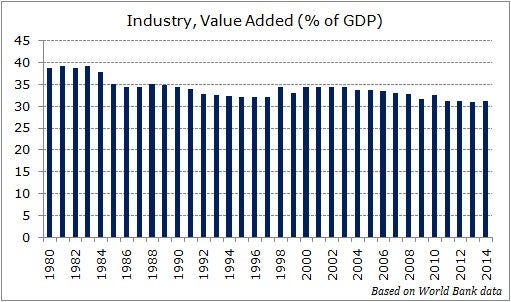
Although the Philippine economy grew at a mediocre pace of 3.5% over the past 35 years (1980-2014), recent numbers project a different story. The average gross domestic product (GDP) growth rate over the past 15 years (2000 onwards) has been 5.1%, while in the past five years (2010-14) it has been 6.3%. A Deloitte Report projects that, “the Philippines will grow faster than Southeast Asia as a whole over the next two decades, with overall GDP expanding by 4.8% per year in the 2014-33 period.” (For more, see: This Asian Nation Is Poised For Steady Growth.)
GDP Composition
The composition of the gross domestic product is broadly split among the agricultural, industrial and service sectors. According to 2014 World Bank data, agriculture accounted for 11.5% of GDP, while the industrial and service sectors accounted for 31% and 57.5%, respectively.
Neglected Agriculture, No More
This low level of productivity and slow growth in the Philippines’ agricultural sector has resulted in high incidence of poverty within the sector. The lack of government initiatives has been primarily responsible for the decline of the agricultural sector, which has suffered from poor infrastructure and low levels of investment. These factors got accentuated with the long seasons of drought that the country suffered.

Fortunately, things seem to be changing as the government is now investing heavily in this sector. The government is backing the Department of Agriculture’s (DA) programs in an attempt to improve food security, rural income and infrastructure. Some initiatives by the DA in a bid to improve the post-harvest losses, while making productive less expensive as well as stabilize labor costs, are Farm Mechanization, National Organic Agriculture and Post-Harvest Development. Then there is the World Bank-supported Philippine Rural Development Project, which aims to improve rural infrastructure. Beyond these, a crop insurance scheme, which will cover the costs of devastating weather phenomena, is being rapidly expanded by the government through Philippine Crop Insurance Corporation. Given these and many more measures, the agricultural sector of the Philippines should witness a spurt in its productivity and output in the near future.
The industrial sector has made a fair and sustained contribution to the GDP of the Philippines over the years, averaging 34% during 1980-2014 and 31% in 2014 alone. The industrial sector is growing faster thanks to lower labor and operations costs in the region. It grew at 9.2% and 7.9% in 2013 and 2014, respectively. The sector employs 16% of the country’s workforce. The government of the Philippines is making efforts to attract foreign direct investment in the country by improving its infrastructure and other paraphernalia. The country has developed a number of economic zones, which have attracted many foreign companies. There are reports that predict some companies are set to relocate their production from China, their traditional base, to the Philippines and neighboring countries in Southeast Asia. These measures will help sustain the growth of the industrial sector in the years to come.
The major industries of Philippines include manufacturing and agribusiness. Within manufacturing, mining and mineral processing, pharmaceuticals, shipbuilding, electronics and semi-conductors are the focus areas. The Philippines is one of the attractive pharmaceutical markets in the Asia-Pacific region. The Philippines is also richly endowed with metallic resources, and the country has attracted many foreign companies to its land. Anglo American plc, BHP Billiton Ltd (BBL), Sumitomo Metal Mining Co Ltd and Xstrata plc are among them. Moreover, the arrival of foreign players has helped the country to capitalize on its shipbuilding potential. The island nation is the fourth-largest shipping country (after China, South Korea and Japan).
The Philippines’ electronic industry has been active since the mid 1970s, when the companies from the West were looking to relocate production facilities to combat the issues of rising cost of production. The electronics industry in the Philippines has only grown bigger and better since then, and is an important component of the nation’s economy in terms of job creation, tax contribution, exports, household income and share in the GDP.
The agribusiness is mainly composed of processed fruits and vegetables, seaweeds, tropical fruit purees and juices, fresh tropical fruits, mango seed oil, sugar plantation, bioethanol, biofuels and coco methyl ester.

BPO-Driven Service Sector
The service sector of the Philippines overtook the industrial sector in terms of contribution to the GDP during the early 1980s, increasing from 36% in 1980 to 57.5% in 2014, according to the World Bank. The services sector employs 54% of the country’s workforce, which is more than the agricultural and industrial sectors combined.
Within the service sector, business process outsourcing (BPO) has played a significant role in sector growth. According to Invest Philippines, “The Philippines gained considerable traction as a BPO location based on the availability of professionals with the required language skills, cultural affinity with the U.S. (the main BPO market), and strong customer service orientation of its workforce. This government openly acknowledged the industry as key driving force for growth and employment in its Medium-Term Philippine Development (2004-2010).”
The second important segment within the service sector is tourism, which has a long history of moderate growth. Tourism in the Philippines has not been able to tap its resources optimally and has lagged behind its regional cousins (like Singapore, Indonesia and Thailand) in attracting international tourists. Inadequate infrastructure (airports, poor rail and road connectivity), insufficient tourist services and facilities are among the chief reasons for this.
Another segment is export services, which includes the services delivered by Filipinos working outside the country as permanent, temporary or irregular migrants. The remittances by Filipinos working abroad have grown substantially over the years. Their jobs have also undergone a structural change from low-end service jobs to more professional jobs that require higher education skills.

Remittances from abroad continue to be strong (at 10% of GDP), and the emergence of the BPO industry is seen as a driver of consumer spending and employment generator on the back of strong foreign earnings. This is turning out to be a good alternative mechanism for the nation. The expanding base and growth prospects of the BPO industry will not only boost the service sector in the country, but could also persuade some of its people to return home while combating the threat of decline in remittances from its people abroad.
The Bottom Line
For any economy to surge ahead, a balanced and harmonious growth of agriculture, industry and services sectors is quintessential. Once these are accomplished, improvements in tertiary sectors of the economy follow quite naturally. For many decades, the Philippines has lagged behind its more affluent Southeast Asian and East Asian neighbors in terms of economic and social development. But those days are gone. The Philippines today appears to be firmly on the path of growth and sustainability. (For more, see: Find The Top Retirement Cities In The Philippines.)
By Prableen Bajpai, CFA (ICFAI)
Source:http://www.investopedia.com/articles/investing/091815/emerging-markets-analyzing-philippines-gdp.asp
No comments:
Post a Comment